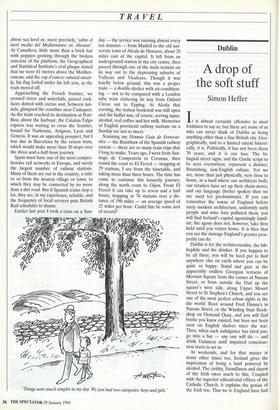Spain
On the right track
Simon Courtauld
In the railway carriage a sign showing a cigarette with a line through it and the words No Fumar was prominently dis- played. Unconcerned, an old man wearing a blue beret and a young woman in trousers were puffing away, deep in discussion over the cost of housing in this part of Catalonia. The ticket collector passed by without mak- ing any protest. When the train stopped at Figueras, they and other passengers got out and walked across the line, ignoring the sign No Pasar. No one bothered to use the subway a little further down the platform, because it was not directly opposite the sta- tion exit.
It is reassuring to find traits of the Span- ish character — independence, stubborn- ness and a distinct whiff of anarchism surviving the country's radical transforma- tion since the death of Franco. And it is good to know that the train in Spain remains a highly efficient, if underrated, form of transport. I am not speaking of the intercontinental expresses, nor of the 'bul- let' train between Madrid and Seville, inau- gurated in 1992, which halves the journey time to under three hours; but rather of the
it's been taken care of'
cross-country services, used by local people to travel between village and town. It was on one of these — the stopping train from Barcelona to the French border at the east- ern end of the Pyrenees — that I observed several passengers last autumn expressing their inalienable right not to do what they were told.
I joined the train at Flassa, three stops north of Gerona, where on a weekday afternoon the station bar was filled with four tables of card-players, all of them smoking and drinking brandy. On one wall the Society for the Protection of Smokers had pinned a notice announcing, 'Mozart was a non-smoker — and he died young.'
Here, and at most stations, the man who sells you a ticket has a different and more important role to play as soon as the train comes in. Grabbing a red flag and a flat- topped red cap, black-peaked and decorat- ed with a silver-leaf cluster, he emerges on to the platform as the station-master. At almost every country halt — except for the smallest, which may be unmanned — the train is greeted and seen on its way by the station-master. It is a delightful custom where are the English station-masters of yesteryear?
Every station also records its height
TRAVEL
above sea level or, more precisely, `sobre el nivel medio del Mediterraneo en Alicante'. At Camallera, little more than a brick but with poppies growing through the broken concrete of the platform, the Geographical and Statistical Institute's oval plaque stated that we were 81 metres above the Mediter- ranean; and the cap d'estacio saluted smart- ly, his flag furled under his left arm, as the train moved off.
Approaching the French frontier, we crossed rivers and waterfalls, passed rock- faces dotted with cactus and, between tun- nels, glimpsed the coastline near Cadaques. As the train reached its destination at Port- Bou, above the harbour, the Catalan-Talgo express was waiting to cross the frontier, bound for Narbonne, Avignon, Lyon and Geneva. It was an appealing prospect, but I was due in Barcelona by the return train, which would make more than 30 stops over the three-and-a-half-hour journey.
Spain must have one of the most compre- hensive rail networks in Europe, and surely the largest number of railway stations. Many of them are out in the country, a mile or so from the nearest village or town, to which they may be connected by no more than a dirt road. But if Spanish trains stop a lot, they are, in my experience, reliable, and the frequency of local services puts British Rail schedules to shame.
Earlier last year I took a train on a Sun-
day — the service was running almost every ten minutes — from Madrid to the old uni- versity town of Alcala de Henares, about 20 miles east of the capital. It left from an underground station in the city centre, then passed through one of the main termini on its way out to the depressing suburbs of Vallecas and Vicalvaro. Though it was briefly below ground, this was a proper train — a double-decker with air-condition- ing — not to be compared with a London tube train clattering its way from Oxford Circus out to Epping. At Alcala that evening, the station bookstall was still open and the buffet was, of course, serving tapas, alcohol, real coffee and hot milk. Memories of English provincial railway stations on a Sunday are not so sweet.
Scanning my Horario Guia de Ferrocar- riles — the Bradshaw of the Spanish railway system — there are so many train trips that I long to make. Years ago, I went from San- tiago de Compostela to Corunna, then round the coast to El Ferrol — stopping at 29 stations, I see from the timetable, and taking more than three hours. The time has come to continue this leisurely journey, along the north coast to Gijon. From El Ferrol it can take up to seven and a half hours, stopping at 76 stations over a dis- tance of 190 miles — an average speed of 25 miles per hour. Could this be some sort of record?
`Things were much simpler in my day. We just had two categories: boys and girls.'



































































 Previous page
Previous page